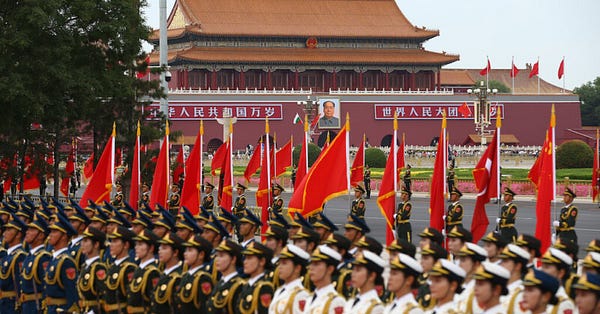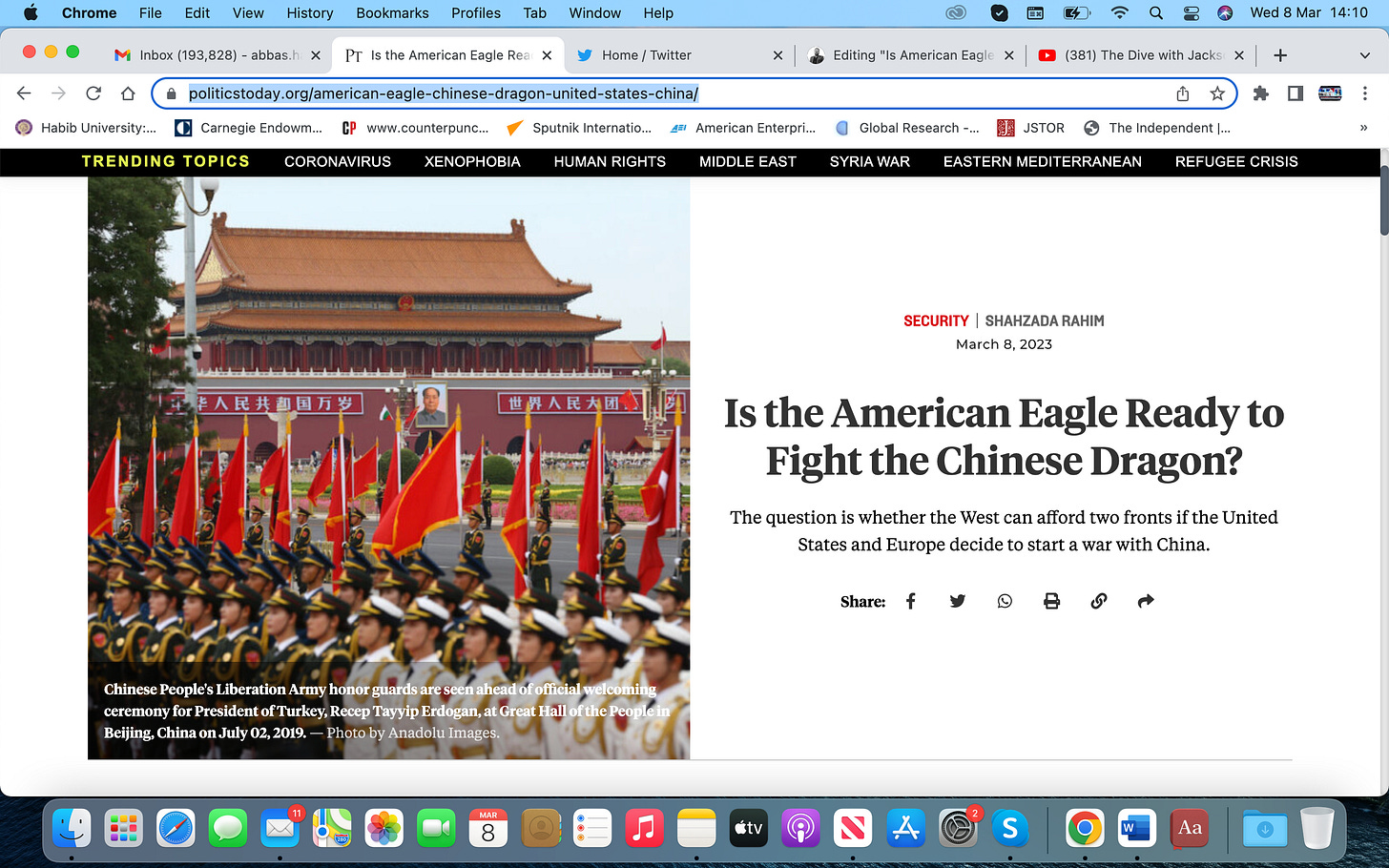Is American Eagle preparing to fight Chinese Dragon?
The Russian Special Military Operation (SMO) in Ukraine has overturned the security pragmatism in the United States, where few military leaders are expecting the confrontation with China by 2025.
A week ago, in a long memo to Air Force wing commanders the four-star Air Force General Mike Minihan, delivered an ominous warning “choring up a possible confrontation with China” in two years. Since the beginning of the Chinese economy back in the 1980s under then-Chinese leader Deng Xiaoping, American multinationals doubled their profits by entering the vast Chinese consumer market. Over the span of decades, China became the most attractive investment destination for western companies and start-ups.




Within decades, China emerged as the manufacturing hub for cheaper goods and services and began boosting its export industry filling state coffers with billions of dollars. By 2010, the People's Republic of China replaced Japan as the Second largest economy in the world shocking the world with its new model of economic development often known by the acronym Beijing Consensus.


In 2012, China saw a change in the political landscape, when Xi Jinping became the new leader of the People’s Republic which was then interpreted by Chinese experts as the beginning of the Chinese Century. The term Chinese century is a complex terminology that is often rooted in Chinese neologism that describes the economic miracle indicating that the 21st century may be geoeconomically or geopolitically dominated by the People's Republic of China. Within a year, in 2013, Xi Jinping announced China’s dream project “One Belt One Road Initiative” often known as the New Silk Route with a new Chinese economic philosophy of a “win-win situation”.
The major commercial ports in the Indian Ocean, which China is currently developing for the claimed commercial use include Gwadar in Pakistan, Hambantota Port in Sri Lanka, Lamu & Mombasa Port in Kenya, Bagamoyo Port & Dar es Salaam Port in Tanzania, Sokhna Port in Egypt, and Sudan Port in the Republic of Sudan.
The One Belt and One Road initiative is China’s global infrastructure development strategy that aims at investing in more than 150 countries around the World. One Belt and One Road often pronounce as OBOR is a multibillion dollars project that aims at investment in building large-scale infrastructure projects such as ports (both dry and sea ports), railways, highways, small and big economic zones, and commercial airfields.
Two hundred years ago, Emperor Napoleon Bonaparte famously remarked that “China is a sleeping giant. Let her sleep for when she wakes up she will move the world.” With Xi Jinping in China, it seems the sleeping dragon has awakened, will it really shake the world" with its movement? ‘as Napolean once predicted? Even before the inauguration of the Belt and Road initiative, in 2004, several U.S. geopolitical experts coined the theory of “String of Pearls” a geopolitical hypothesis that speculated the Chinese domination in the Indian oceans via commercialization of key ports by establishing lanes of communication that will connect mainland China with the Horn of Africa.
The major commercial ports in the Indian Ocean, which China is currently developing for the claimed commercial use include Gwadar in Pakistan, Hambantota Port in Sri Lanka, Lamu & Mombasa Port in Kenya, Bagamoyo Port & Dar es Salaam Port in Tanzania, Sokhna Port in Egypt, and Sudan Port in the Republic of Sudan. There are several other small ports, which China is planning to jointly develop with relevant governments in the latter countries.
As per Chinese claims, these ports are exclusively being developed for commercial purposes but U.S. geopolitical experts see the growing Chinese sphere of influence over the Indian Ocean as a growing threat. In his well-celebrated book “Monsoon: The Indian Ocean and the Future of American Power,” American political scholar Robert D. Kaplan Kaplan observes that US power and influence are trending downward, while China is rising in both elements across the region.
Chinese leader Xi Jinping elucidated the foundation of the Chinese Century in his famous Nineteenth National Congress address to the Communist party in 2017. In this address, citing the classical Confucian concept of tianxia (天下), or "all under heaven," Xi Jinping explained his vision for China's role in facilitating the development of various regions around the world.
However, the Chinese leadership refutes these claims and defends its commercialization of major ports in the Indian Ocean as a pathway to boost China’s trade relations with the countries in Asia and Africa. The rapid success of key infrastructural development ports under the shadow of the One Belt and One Road Initiative clearly suggests the beginning of the Chinese Century. According to Chinese historians and political experts “Chinese Century” under the leadership of Xi Jinping suggests the unification of China’s three key historical traditions. For instance, in his 2012 seminal lecture entitled “ Unifying the Three Traditions” in the New Era: The Merging of Three Chinese Traditions” at Tsinghua University, Chinese philosopher Gan Yang explains how China under the leadership of Xi Jinping is flourishing across the political, social, economic and Cultural spheres. Gan Yang told the audience referring to history of China in the 21st century;
“Modern Chinese history refers to a new understanding of the links and continuities between the success of reform and opening and the Mao era, as well as a new understanding of the foundational role that traditional Chinese history and civilization have played in modern China.”
Jiang Shigong, another Chinese philosopher and an expert on Martin Heidegger shares the same pragmatism about the beginning of the Chinese Century in his essay “ Empire and World Order”. Referring to Chinese isolation in the mid-twentieth century after the communist revolution and its emergence as a global power in the 21st century Shigong explains the process in the following way:
“the progression of world history as the progress of smaller political units towards larger conglomerations, or empires, culminating in the latest phase of “world empire”.
Likewise in his other renowned essay “Philosophy and History: Interpreting the ‘Xi Jinping Era’ through Xi’s Report to the Nineteenth National Congress of the CCP” Jiang Shigong explains Xi Jinping's notion of “ Socialism with Chinese Characteristics” in the following way":
“Socialism with Chinese Characteristics has entered a new age, meaning that the Chinese people, who have long suffered in the modern age, have now made a great leap, from standing up 站起来 to becoming rich 富起来, to becoming strong 强起来." "Standing up," "getting rich," and "becoming strong" are ways to divide the histories of our Party and our Republic, referring respectively to the Mao Zedong era, the Deng Xiaoping era, and the Xi Jinping era”.
Chinese leader Xi Jinping elucidated the foundation of the Chinese Century in his famous Nineteenth National Congress address to the Communist party in 2017. In this address, citing the classical Confucian concept of tianxia (天下), or "all under heaven," Xi Jinping explained his vision for China's role in facilitating the development of various regions around the world. Today, across the geoeconomic and geopolitical spheres, China is a leading competitor of the west and it was the Chinese economic miracle of the recent century that propelled China to pick the race with the U.S. empire. Now the question arises will this competition turn into a confrontation?
Since the last decade, Eagle and Dragon are facing off against each other on various fronts. For instance, the Trump trade war with China in 2016 was the beginning of this direct face-off, which widened the economic distrust between the west and China. Likewise, Chinese claims to the nine dotted line in the South China Sea also became a major sign of this face-off that continues to this day. Very recently, Chinese neutrality and a light tone of support for Russia’s Special Military Operation in Ukraine further escalated the already tense diplomatic and economic confrontation of the west with China. In response to China’s silence over the Ukrainian conflict, the western nations have collectively decided to deprive China of chip imports, which are essential to its booming telecommunication technological progress.
The ongoing western sanctions policy against China and Russia clearly demonstrates a calm before the storm. The question is can the west afford two fronts if the U.S. and Europe decided to start a war with China? The recent ominous warning of the four-star Air Force General Mike Minihan about the possible war with China by 2025 clearly signals a worsening situation in the already conflict-ridden world. It is time the global powers should think about the collective humanity because growing global insecurity signals the leaders 'Even something as trivial as a nail clipping'.





